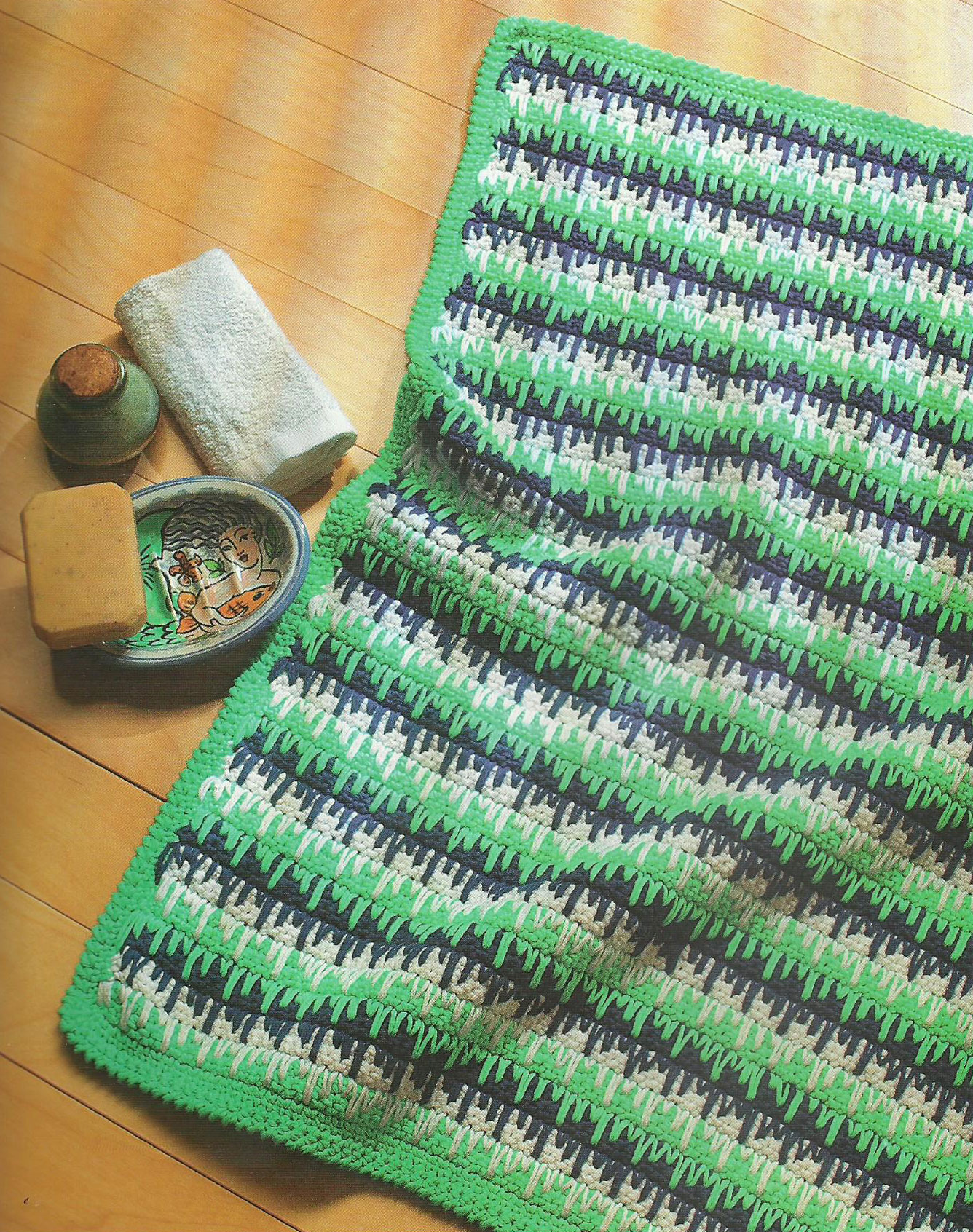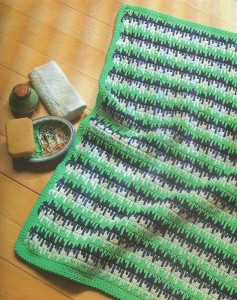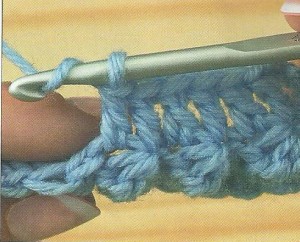Bathroom Rug
This rug is made from soft cotton which feels luxurious under bare feet and soaks up any little spills. The spike stitches are placed to give the illusion of diagonal triangles (triangle spike stitch). As this pattern uses three colours you may prefer to cut off the ends – trying to carry them up the side of your work could lead to tangles.
You will need
200g soft cotton DK yarn in colour B
200g soft cotton DK yarn in colour C
4.50mm hook
Size: 50 x 92cm (19/2 x 32in)
Tension: 8 sts and 7 rows measure 5cm (2in) worked over dc on 4.50mm hook
Tip
If you do not want a finishing border for your mat, fasten off the yarn as you complete each band of colour
Rug
Using A, make 73 ch.
Row 1: ldc in 3rd ch from hook, ldc in each ch to end, lch, turn (72 sts). Row 2: 1 dc in each st to end, lch, turn.
Rep row 2 twice, joining in B before end of last st.
Row 5 (spike stitch): * ldc 2 rows below, ldc 3 rows below, ldc 4 rows below (i.e. in the base of the st in the foundation ch), rep from * to end, lch, turn.
Work 3 rows dc, joining in C in last dc of 3rd row, lch, turn.
Row 9 (spike stitch): * 1 dc 4 rows below (top of previous colour band), 1 dc
rows below, ldc 2 rows below, rep from * to end, lch turn.
Work 3 rows dc joining in A in last dc of 3rd row, lch, turn.
Row 13 (spike stitch): * ldc 2 rows below, ldc 3 rows below, ldc 4 rows below (top of previous colour band), rep from * to end, lch, turn.
Rep rows 6-13 inclusive, changing colours in the sequence ABC at the same time. End the mg design with row 13.
Using A, work 1 row of dc.
Rows 4 to, 11 form patt. Rep these 8 rows until work measures as close to 92cm (32in) as possible, ending with row 11.
Note: rows 6-13 form patt, but the colour change covers 12 rows.
Border
Rnd 1: using A and with RS facing, work ldc in each st across top and bottom edge of mg, 2dc in each comer st, 1 dc in each st up side of mg, spacing dc so there are 3dc over every 4 row ends. Join with ss.
Next rnd: crab stitch around edge – no extra sts needed at corners.
Fasten off.
To complete
If you cut off the yam ends, sew these in before working the border. An alternative is to loop ends through with a small crochet hook, then work the border over them. The dc will enclose the ends and give a neat finish.
Clusters
Clusters are used to add texture to a variety of crochet fabrics. They are formed when stitches are drawn together at the top, and may be grouped in a single base stitch – the most usual way – or spread over a number of stitches. The number in front of the abbreviation shows how many stitches to use. The three treble cluster (3trcl) is the most popular, though four, five or more stitches can be used. Clusters worked into one stitch are best made with the wrong side of the work facing. They can also be used for decreasing
A standard 3trcl needs a turning chain the same height as the stitches between the clusters. A 3trcl in a row of dc needs only one turning chain, but a 3trcl in a row of trebles needs three turning chains
Tip
Clusters are more pronounced when they are set in rows of shorter stitches. For a cluster that stands out effectively in treble fabric, try making it with four double trebles.
- Insert the hook in the stitch, yoh…
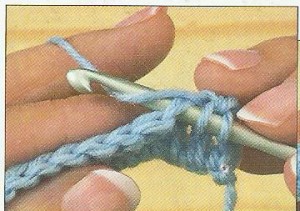
- … and pull through to the front (three loops on the hook).
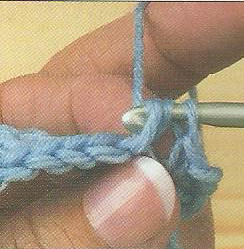
- Yoh and pull through two loops…
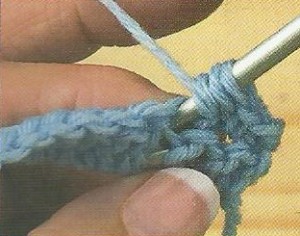
- …yoh and insert the hook in the same stitch.
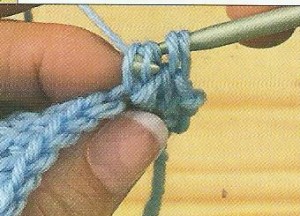
- Yoh, pull through to the front.
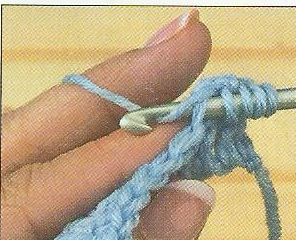
- Yoh, pull through to the front.
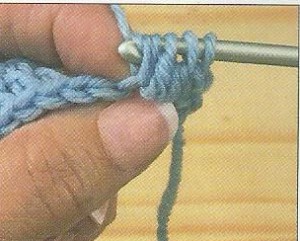
- ..so there are four loops on the hook yoh..
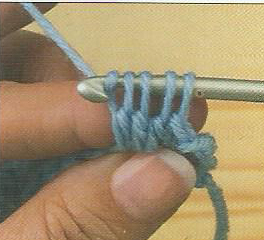
- … and pull through the remaining four loops.
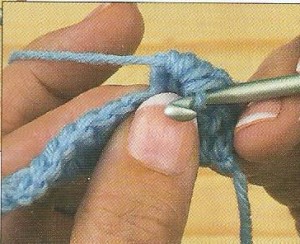
- . Insert the hook in the next stitch, pushing the cluster away from you to the front of the work, yoh.
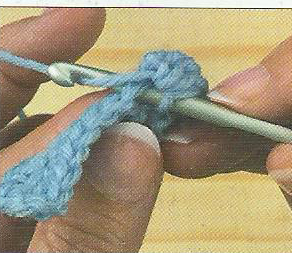
SHELL PATTERNS
Groups of stitches worked into one stitch form shells, which can be used to make an attractive scalloped edging for a variety of items. You will need a number of stitches divisible by six with one stitch left over. On square or rectangular items, try to ensure that the dc of the shell edging falls at the comer. If the centre of a treble cluster falls at a comer, add two more trebles to it to provide enough ease to turn. Repeat the steps to the end of your work, then fasten off.
- Make l ch to lift the hook to the right height.
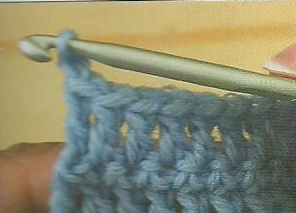
- Miss two stitches, insert the hook in next stitch…
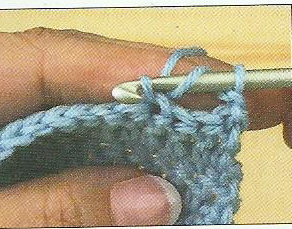
- …and work five trebles in stitch.
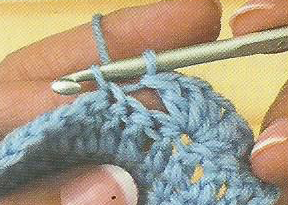
- Miss 2 sts, work l dc in the next stitch. Repeat to the end.
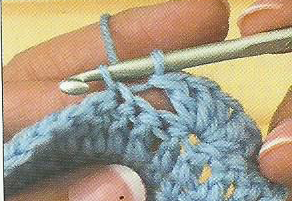
FABRICS USING SHELLS
Working a second row into a row of shells removes the scalloped look, and adding more rows produces an attractive all-over pattern for fabric. This can be done by working treble clusters that look like inverted shells, using smaller clusters at the beginning and end of each row. Start with the shell edging, worked into a chain that is a multiple of six stitches plus one.
- Work 3ch, turn. Work an ‘unfinished’ treble into the first stitch…
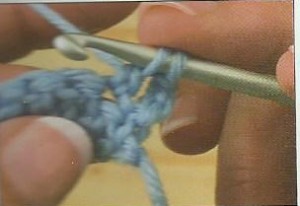
- ..and another into the next stitch.
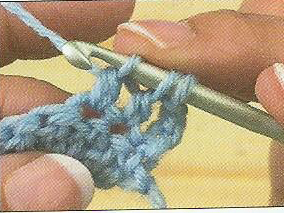
- Yoh, pull through all three loops on the hook (tr2tog completed).
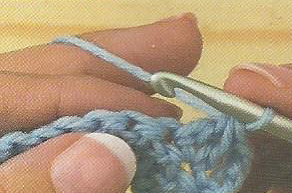
- Work 3ch, then work ldc into the centre treble of the 5tr shell.
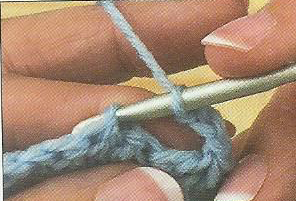
- Work 3ch…
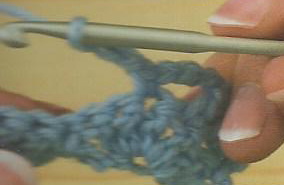
- ..then work one unfinished treble in each of the next five stitches.
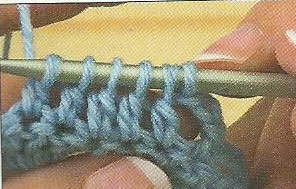
- Yoh and draw through all five stitches.
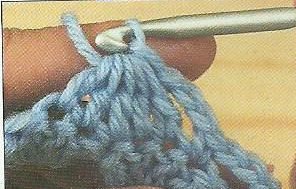
- Repeat steps 4-7 to the end of the row.
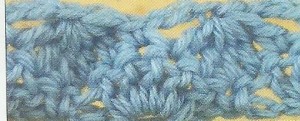
source beginner’s guide to crochet (pauline turner)

